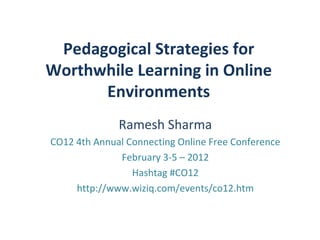Pedagogical Strategies for Worthwhile Learning in Online Environments
- 1. Pedagogical Strategies for Worthwhile Learning in Online Environments Ramesh Sharma CO12 4th Annual Connecting Online Free Conference February 3-5 – 2012 Hashtag #CO12 http://www.wiziq.com/events/co12.htm
- 2. Worthwhile Learning • Socrates: different kinds of knowledge (important and trivial) • Two very different sorts of knowledge – ordinary knowledge – definitional knowledge
- 3. Meaningful Learning • Ausubel (1963) – Learner’s previous experiences present in his cognitive structure and the learning content are compatible with that cognitive structure Ausubel, D. P. (1963). The Psychology of Meaningful Verbal Learning. New York: Grune and Stratton
- 4. Chief features • Active • Authentic • Constructive • Cooperative
- 5. Active • Learner should possess a motive to learn and actively engage in worthwhile learning
- 6. Authentic • When the learning tasks can be displayed in a real environment or in a situational learning environment to help learners to better understand them
- 7. Constructive • To make learners truly understand what they have learned and reflect what they have observed in the process of learning
- 8. Cooperative • Cooperation with peers to obtain suggestions and knowledge
- 9. Online higher education market in 2015 • Hazel Associates (2005):by 2015 the online higher education market would exceed $69 billion and found it to be the fastest growing sub-sector in global education market. Hazel Associates. (2005). Global e-learning opportunity for U.S. higher education. Retrieved from http://www.hezel.com/globalreport/
- 10. Lack of Pedagogical Considerations • Weigel (2000): Online courses lacked any pedagogical considerations, rather being “ little more than an exercise of posting on the Internet an enhances syllabus that includes lecture content, reading assignments and practice tests along with using discussion groups and e-mails to respond to students questions” Weigel, V. (2000). E-learning and the tradeoff between richness and the reach in higher education. Change, 33(5), 10-15.
- 11. Effectiveness of web: a disappointment • Carr-Chellman and Duchastel (2000) – It is also evident that many online courses lack basic design consideration and that the web is simply being used as a medium for delivery of instructions created within another framework. Such transposition from one medium to another may have some value in reaching certain outreach goals, but it also run serious risks of diluting the original instruction and possibly rendering it ineffective (p.229). Carr-Chellman, A., & Duchastel, P. (2000). The ideal online course. British Journal of Educational Technology, 31(3), 229-241.
- 12. Usage pattern of online education practices Integrated Mixed / Blended Independent Supplement to Complement to Alternate to face-to-face face-to-face face-to-face teaching teaching teaching
- 13. Engaging for worthwhile learning • In whatever way the online education practices are used, trends showed a need for a paradigm shift from teacher to student centered learning; from simply passing on knowledge to constructions of knowledge and collaboration (Salmon, 2000; Bates, 2001; Laurillard, 2002). Bates, T. (2001). National strategies for e-learning in post-secondary education and training. Paris, France: UNESCO, IIEP Laurillard, D. (2002). Rethinking university teaching: A conversational framework for the effective use of learning technologies. London, UK: Routledge Salmon, G. (2000). E-moderating: The key to teaching and learning online. London, UK: Kogan Page.
- 14. Strategies for engaging learners • constructivism (Hung, 2001) • web-constructivism (Basiel, 1999) • learning by doing (Schank, 1997) • problem-based learning (Barrows, 1994) Barrows, H. S. (1994). Problem-based learning applied to medical education. School of Medicine, Springfield, IL: Southern Illinois University. Basiel, A. (1999). Applied formative evaluation in the Web-based environment. MPhil. Thesis in Computing Science, Middlesex University, London. Hung, D. (2001). Design principles for web-based learning: Implications for Vygotskian thought. Educational Technology, 41(3), 33-41. Schank, R. (1997). Virtual learning: A revolutionary approach to building a highly skilled workforce. New York, NY: McGraw-Hill.
- 15. Strategies for engaging learners • case-based learning (Chen et al, 2006) • learning by designing (Naidu, Anderson, and Riddle, 2000) • role-play-based learning (Ip, and Linser, 1999) • an eclectic approach in instructional design for web-based learning (Mishra, 2002). Chen, C. C., Rong-An, S., & Harris, A. (2006). The efficacy of case method teaching in an online asynchronous learning environment. International Journal of Distance Education Technologies, 4(2), 72-86. Ip, A., & Linser, R. (1999). Web-based simulation generator: Empowering teaching and learning media in political science. Retrieved from http://www.roleplaysim.org/papers/rpsg.htm Mishra, S. (2002). A design framework for online learning environments. British Journal of Educational Technology, 33(4), 493-496. Naidu, S., Anderson, J., & Riddle, M. (2000). The virtual print exhibition: A case of learning by designing. In R. Sims, M. O'Reilly & Sawkins, S. (Eds.), Learning to choose: Choosing to learn (short papers and works in progress) (pp. 109-114). Lismore, Australia: Southern Cross University Press.
- 16. ERIC Model • Sharma and Mishra (2007) suggested Experience-Reflect-Interact-Construct (ERIC) model for learner engagement in digital environments. CONSTRUCT EXPERIENCE EXPERIENCE REFLECT Sharma, R. C. & Mishra, S. (2007). Cases on global e-learning practices: Successes and pitfalls. Hershey, PA: Idea Group Publishing.
- 17. Kawachi’s Multimedia Learning Model Kawachi, P. (2005). Empirical validation of a multimedia construct for learning. In S. Mishra, & R. Sharma (Eds.), Interactive multimedia in education and training, (pp. 158-183). Hershey, PA: IDEA Group
- 18. Final comments • Not all institutions are online, yet it is true that perhaps all now use some form or other of electronic technology known as e-learning • e-learning has not demonstrated improved learning ? • Teachers do not know how to employ e-learning efficiently • reduce the psychological transactional distance between the individual student and the content to be learnt
- 19. Thank You!

